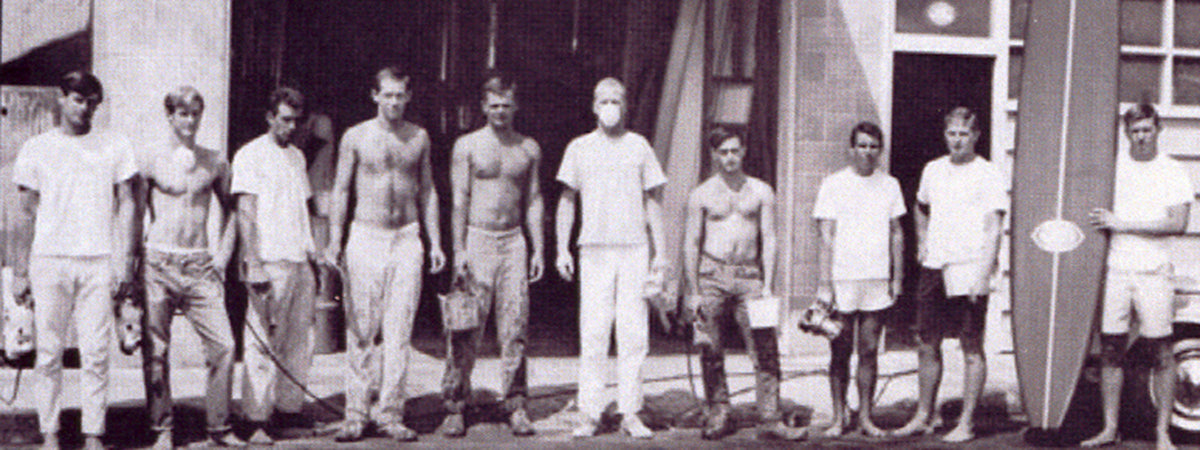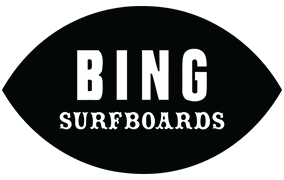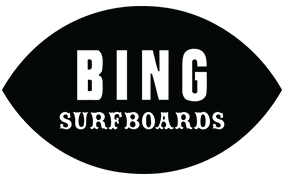- SURFBOARDS
- BING GEAR
- SURF GEAR
- BRAND FAVS
- BOOKS
- GIFT GUIDE
- Team
- VISUALS
- Log in
-

BING SURFBOARDS
OUR HISTORY
Bing Copeland began surfing in 1949, at age 13, at the Manhattan Beach pier with his friend Greg Noll, who was a bait boy on the end of the pier. Bing and Greg were surfing gremmies that began their friendship hanging on the railing watching the older guys surf the big heavy redwood boards.
One of the older guys, Dale Velzy, was a lifeguard on the pier at the time and loaned them an 8 foot 80 lbs redwood surfboard to try out. From then on, Bing was hooked as was his friend Greg. Both of them hung around Velzy’s first shop for years helping sweep up, gluing up balsa blanks, shaping wood fins and repairing boards.
Bing attended Mira Costa High School in Manhattan Beach until he graduated in 1954. That summer Bing, along with Greg, Vardeman and Hap Jacobs, became lifeguards, which allowed them to earn enough money for a trip to Hawaii. In September of 1955, at 19, Bing flew to Hawaii. He started out in a Waikiki rental and then moved to a Makaha Quonset hut with his friends, Sonny Vardeman, Rick Stoner, Steve Vorhees, Mike Bright, and George Kapoo, where they gradually learned to ride the big surf with the mentoring of George Downing, Buzzy Trent and Peter Cole. With their funds running low, Bing and Rick Stoner both went into the Coast Guards and were luckily assigned to a ship in Hawaii for the next 2 years where they spent all their leave-time surfing and pioneering much of the North Shore.
In 1958 Bing along with Rick Stoner decided to sail around the world. They first sailed to Tahiti then continued on to Fiji and eventually New Zealand where they introduced modern surfing and surfboards to the Kiwi’s.
Bing opened his first surf shop in the fall of 1959 with his friend Rick Stoner and became one of the major surfboard manufactures of the sixties and early seventy’s. A year after they opened, Rick decided to sell Bing his portion of the business thus came Bing Surfboards.
The business grew at an exponential rate, and Bing expanded his factory to include a glassing area and a team of first-rate shapers, including Dick Mobley, Mike Eaton, Dan Bendiksen, John Mobley, Wayne Land, and George Lanning and then eventually Dick Brewer also joined the team.
At one point, the factory produced up to 40 surfboards a day. In addition to his board-building team, Bing also had a star team of riders, including David Nuuhiwa, Dru Harrison, Chris Schlickenmeyer, and Rolf Aurness just to name a few.
The late 60s was the beginning of the end for the major manufacturers. It was a time of the “back yard board” and “no label” surfboards. Bing along with his master shapers and new designers, the Campbell Brothers, transitioned to shorter boards with a few models, but despite Bing Surfboard’s continued popularity, sales declined and it became obvious to Bing that the business may not survive. It was also around this time that Bing and his wife, Conlee, decided it might be best to move their young family away from the drug scene that had developed surrounding Hermosa Beach. Bing decided to pursue a career change and moved his family to Idaho.
In 1974, G&S took on the license of Bing Surfboards then Mike Eaton continued the Bing legacy through the 80s and 90s. Until one day in Baja in 2000, where Bing and his family spend their winters, Bing was surfing one of his favorite spots and a car pulled up with a group of young guys. One of the guys approached Bing and claimed to owe him some royalty money for some Bing & Rick surfboards that he had made for Rick Surfboards.
This young man then offered to make Bing’s boards if he was ever interested. Bing casually mentioned this to his good friend Mike Eaton, who had been building the boards up until then, and Mike was happy to pass along the legacy to the new generation of surfboard shapers. This young man was Matt Calvani. To this day, Bing and his family live in the mountains of Idaho and spend their winters surfing in the warm waters of southern Baja, not forgetting to stop in on Matt and his surfboard manufacturing team located in Encinitas, CA.
One of the older guys, Dale Velzy, was a lifeguard on the pier at the time and loaned them an 8 foot 80 lbs redwood surfboard to try out. From then on, Bing was hooked as was his friend Greg. Both of them hung around Velzy’s first shop for years helping sweep up, gluing up balsa blanks, shaping wood fins and repairing boards.
Bing attended Mira Costa High School in Manhattan Beach until he graduated in 1954. That summer Bing, along with Greg, Vardeman and Hap Jacobs, became lifeguards, which allowed them to earn enough money for a trip to Hawaii. In September of 1955, at 19, Bing flew to Hawaii. He started out in a Waikiki rental and then moved to a Makaha Quonset hut with his friends, Sonny Vardeman, Rick Stoner, Steve Vorhees, Mike Bright, and George Kapoo, where they gradually learned to ride the big surf with the mentoring of George Downing, Buzzy Trent and Peter Cole. With their funds running low, Bing and Rick Stoner both went into the Coast Guards and were luckily assigned to a ship in Hawaii for the next 2 years where they spent all their leave-time surfing and pioneering much of the North Shore.
In 1958 Bing along with Rick Stoner decided to sail around the world. They first sailed to Tahiti then continued on to Fiji and eventually New Zealand where they introduced modern surfing and surfboards to the Kiwi’s.
Bing opened his first surf shop in the fall of 1959 with his friend Rick Stoner and became one of the major surfboard manufactures of the sixties and early seventy’s. A year after they opened, Rick decided to sell Bing his portion of the business thus came Bing Surfboards.
The business grew at an exponential rate, and Bing expanded his factory to include a glassing area and a team of first-rate shapers, including Dick Mobley, Mike Eaton, Dan Bendiksen, John Mobley, Wayne Land, and George Lanning and then eventually Dick Brewer also joined the team.
At one point, the factory produced up to 40 surfboards a day. In addition to his board-building team, Bing also had a star team of riders, including David Nuuhiwa, Dru Harrison, Chris Schlickenmeyer, and Rolf Aurness just to name a few.
The late 60s was the beginning of the end for the major manufacturers. It was a time of the “back yard board” and “no label” surfboards. Bing along with his master shapers and new designers, the Campbell Brothers, transitioned to shorter boards with a few models, but despite Bing Surfboard’s continued popularity, sales declined and it became obvious to Bing that the business may not survive. It was also around this time that Bing and his wife, Conlee, decided it might be best to move their young family away from the drug scene that had developed surrounding Hermosa Beach. Bing decided to pursue a career change and moved his family to Idaho.
In 1974, G&S took on the license of Bing Surfboards then Mike Eaton continued the Bing legacy through the 80s and 90s. Until one day in Baja in 2000, where Bing and his family spend their winters, Bing was surfing one of his favorite spots and a car pulled up with a group of young guys. One of the guys approached Bing and claimed to owe him some royalty money for some Bing & Rick surfboards that he had made for Rick Surfboards.
This young man then offered to make Bing’s boards if he was ever interested. Bing casually mentioned this to his good friend Mike Eaton, who had been building the boards up until then, and Mike was happy to pass along the legacy to the new generation of surfboard shapers. This young man was Matt Calvani. To this day, Bing and his family live in the mountains of Idaho and spend their winters surfing in the warm waters of southern Baja, not forgetting to stop in on Matt and his surfboard manufacturing team located in Encinitas, CA.
News & Updates
Sign up to get the latest on sales, new releases and more…
SOCIAL MEDIA
To stay up to date with Bing Surfboards, follow us on our social media channels. We post daily, and would be happy to have you join us on staying current with Bing!
Links
OUR LOCATION
Visit our shop in Encinitas, CA!
BING SURFBOARDS
974 N COAST HIGHWAY 101
ENCINITAS, CA, 92024
SHOP HOURS
MON - SUN: 10am - 6pm
THANKSGIVING - CLOSED
CONTACT US
760-944-6300
retail@bingsurf.com
© 2025 Bing Surfboards. Quality Manufacturing Since 1959



